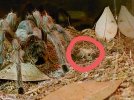- Messages
- 1,744
- Location
- Queens, NY
What are you using to feed her if you do not mind me asking? It might be interesting to offer her something soft and cut in half that you would at least leave overnight. A. chalcodes have a slow growth and mine goes sometimes many months without eating while staying plump but yours appearance is concerning, especially the wrinkles on her abdomen. As @regalspottedbeast mentioned, I thought about dehydration first but with her sucking stomach intact on her molt it is no longer likely. Please try the "soft" prey cut in half and let us know, if it doesn't work I would leave her alone a whole week without disturbance to avoid the stress before trying to offer her food again.The couple who sold the T to me said that she was 5-6 years old, which I'm not sure I believe if it's a mature female, also considering the size of her head and fangs. I will contact them tomorrow and see if I can get any more information. But it's hard since they got it from some aquantice who knew a lady who had the spider, plus the fact that they knew absolutely nothing about tarantulas. They didn't even know that females live longer than males and thought that keeping tarantulas with rocks for substrate and throwing in 10 crickets at a time was a good idea... to mention some things. One of her spineretts have been bitten off and one of the lungs look swollen and strange, but she did eat once before molting.
